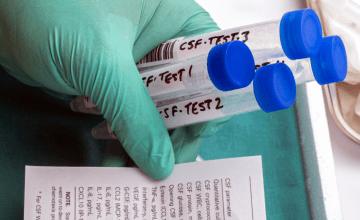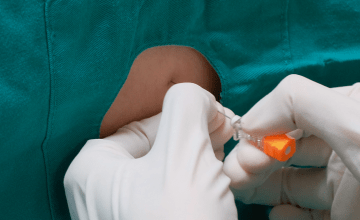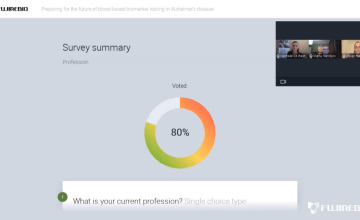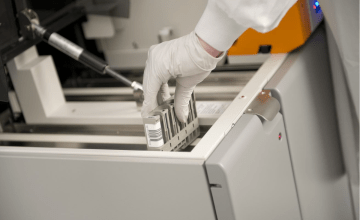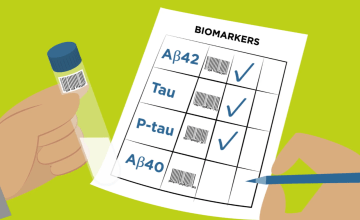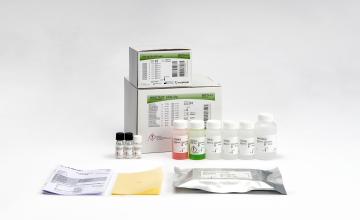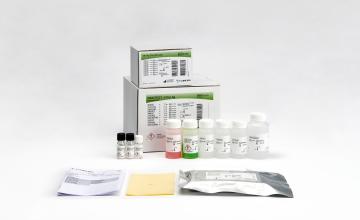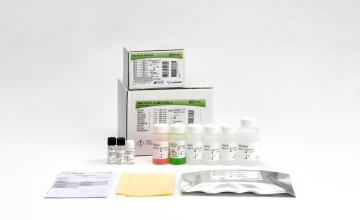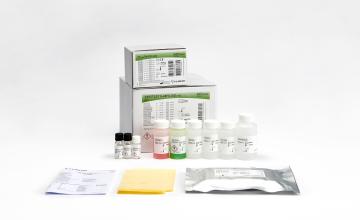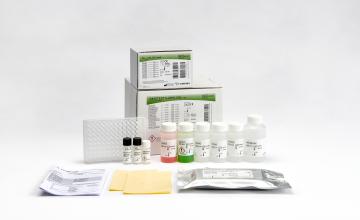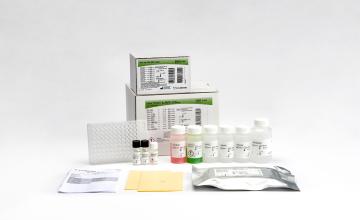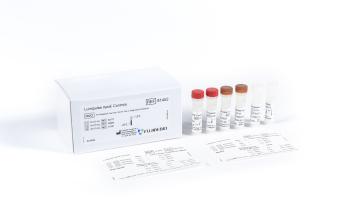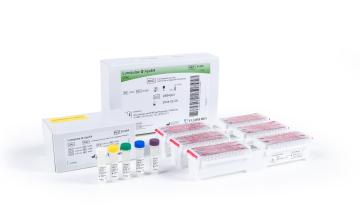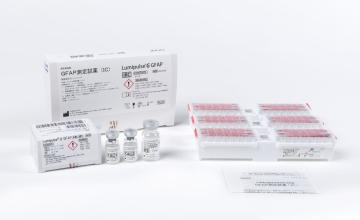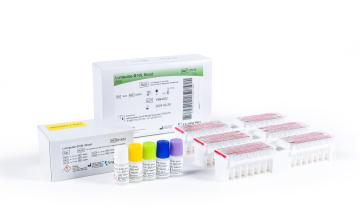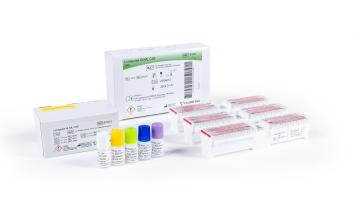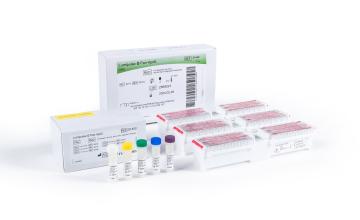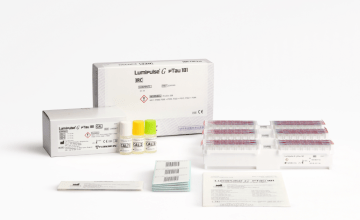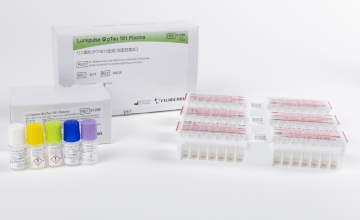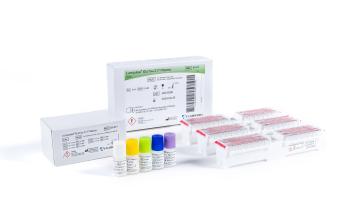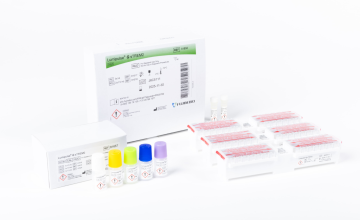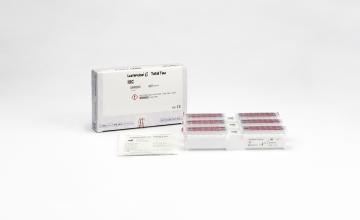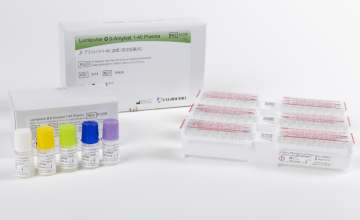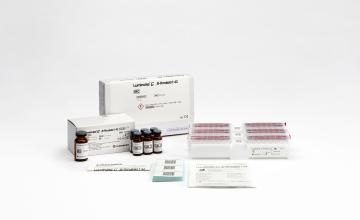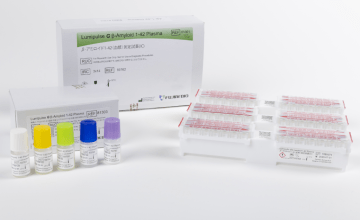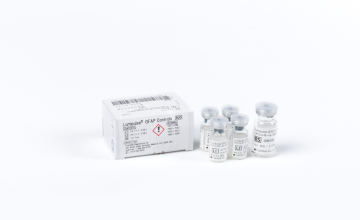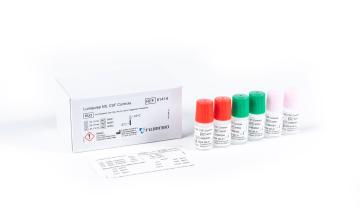How to perform a lumbar puncture
In this article series we aim at highlighting the current state of knowledge and the latest developments in the field of Alzheimer’s disease (AD) testing. This chapter lists recommendations for the performance of a lumbar puncture, necessary to collect your CSF samples.
Other articles in this series:
- Altered proteins in brain neurodegenerative diseases
- Using CSF biomarkers to link pathology and clinical presentation
- Handling and transportation of CSF samples
- CSF biochemical pattern interpretation
- Aβ deposition and clearance: a key feature of ageing brain
- New criteria for Alzheimer’s disease
In collaboration with Prof. Claire Paquet (Neurologist, Center for Cognitive Neurology, Lariboisière Fernand Widal Hospital - APHP - Paris Diderot University, France) we have produced a short, pocket-sized leaflet that explains the basics of how to perform a lumbar puncture.
Download the Practical guide for lumbar puncture here
We also recommend you watch this video tutorial created together with Prof. Claire Paquet:
How to prevent side effects
Post-lumbar puncture headache (PLPH) is best explained by spinal fluid leakage due to delayed closure of a dural defect but there is no link between the quantity of collected CSF and the risk of PLPH.
The use of an atraumatic Sprotte needle reduces the incidence of post-lumbar puncture headaches.
Different needle designs are available. Cutting bevel needles (standard Quincke and Yale) are the standard needles with a medium cutting bevel and an orifice at the needle tip. Atraucan, Pecan, Sprotte, and Whitacre needles are noncutting, pencil-point, and atraumatic needles.

Among patients who had a lumbar puncture, atraumatic needles are associated with a decrease in the incidence of post-dural puncture headache and in the need for patients to return to the hospital for additional therapy, and had similar efficacy to conventional needles.
Conventional needles
Medium (23G-24G) cutting bevel needles are most frequently used in clinical practice. Different hubs with size marking and cannulas of varying diameters and lengths can be used for different patients’ needs (e.g., for overweight patients).
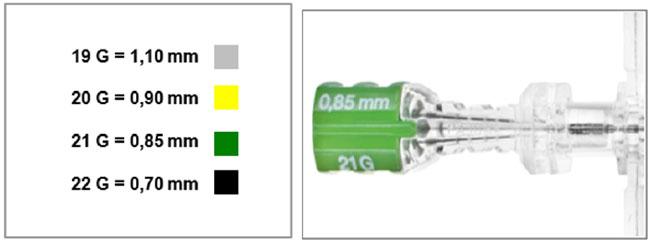
Needle characteristics based on needle length, size, and design
(systematic literature review 2016; consensus guidelines 2017)
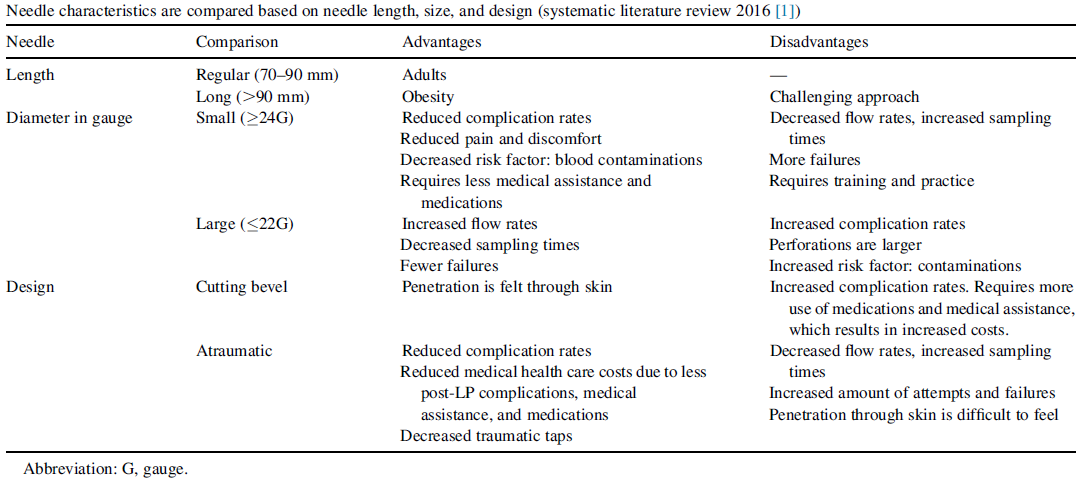
History of atraumatic needles
In 1890 H.I. Quincke invented the Quincke cannula - lumbar puncture has become an established part of neurological diagnosis since then. In 1979 the first atraumatic cannula, developed by Prof. Sprotte, was launched.
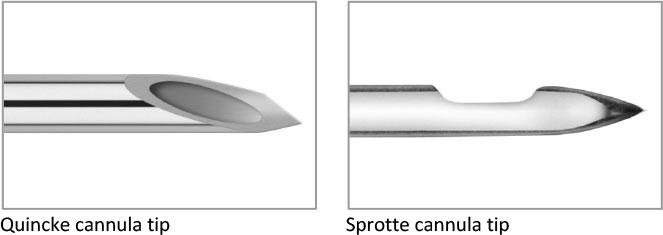
Atraumatic needles allow better fluid flow while at the same time reducing the incidence of post-lumbar puncture headaches, therefore, they decrease post-puncture morbidity and improve the efficiency of diagnosis.
The closed, ogive-shaped cannula tip displaces tissue during puncture rather than cutting it (compared to the cutting tip of the traumatic cannula). The lateral eye has rounded edges, and is sealed precisely by the stylet during puncture. After the retraction of the cannula, the multi-layered texture of the dura of collagen and elastic fibers closes again.
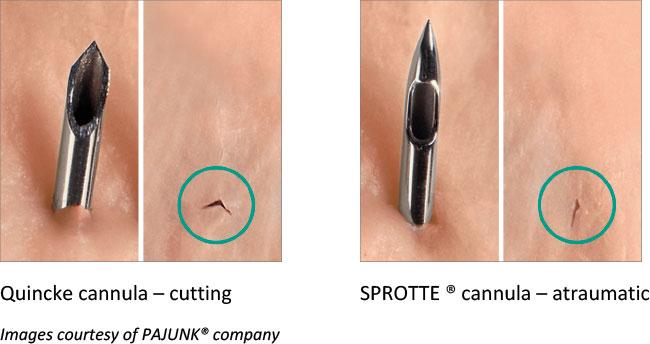
The surfaces of the atraumatic cannula are polished and free from burrs. This enables the atraumatic cannula to be positioned very accurately, while the smooth inner surface of the cannula optimizes fluid reflux.
Since 2005 the American Academy of Neurology (AAN) recommends the use of atraumatic needles (level A recommendation) for spinal anesthesia as well as for diagnostic lumbar puncture since there is firm scientific evidence of the benefits of atraumatic puncture of the fluid space.
A study from 2012 involving direct comparison between traumatic and atraumatic cannula, confirms the superiority of the atraumatic cannula. Post-lumbar puncture headache was much less common in patients treated with an atraumatic cannula.
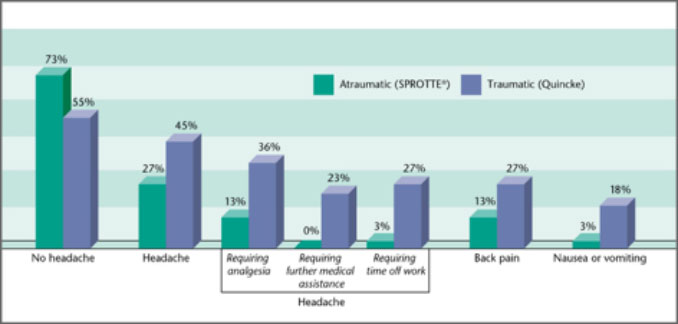
Bibliography
- Atraumatic versus conventional lumbar puncture needles: a systematic review and meta-analysis. Nath S, et al. Lancet. 2017; 391(10126): 1197-1204. Review.
- Consensus guidelines for lumbar puncture in patients with neurological diseases. Engelborghs S, et al. Alzheimers Dement (Amst). 2017; 8: 111-126.
- Lumbar puncture in patients with neurologic conditions. Babapour Mofrad R, et al. Alzheimers Dement (Amst). 2017; 8: 108-110.
- Introduction of Sprotte needles to a single-centre acute neurology service: before and after study. Vakharia VN & Lote H. JRSM Short Rep. 2012; 3(12): 82.
- Lumbar Puncture: It Is Time to Change the Needle? Lavi R, et al. Eur Neurol. 2010; 64: 108-111. Review.
- Assessment: prevention of post-lumbar puncture headaches. Report of the Therapeutics and Technology Assessment Subcommittee of the American Academy of Neurol. Evans RW, et al. Neurology. 2000; 55(7): 909-914. Addendum: Neurology. 2005; 65(4): 510-512.
- Standard vs atraumatic Whitacre needle for diagnostic lumbar puncture: a randomized trial. Lavi R, et al. Neurology. 2006; 67(8): 1492-1494. Randomized Controlled Trial.
Related articles
Fujirebio introduces its Neuro Expert Toolbox (NExT) at AAIC 2025
Fujirebio is introducing its Neuro Expert Toolbox (NExT) for the first time at AAIC 2025 (Alzheimer's Association International Conference®) in...
Video - Alzheimer's awareness redefined
Follow the journey of the Sullivan family and leading Alzheimer’s Neurologist and Researcher Dr. David Greeley as they introduce and explain these...
Publication - Serum and cerebrospinal fluid neurofilament light chains measured by SIMOA™, Ella™, and Lumipulse™ in multiple sclerosis naïve patients
We would like to draw your attention to a first publication on our Lumipulse® G NfL solution. In this article you will find a method comparison of CSF...
CTAD 2023 – Spotlight on recent advances in blood-based biomarkers for Alzheimer’s disease
Both fluid and imaging biomarkers provide biological evidence for the underlying etiology of cognitive impairment. The core fluid biomarkers of...
IVDR status update for Fujirebio’s Neuro products
The European CE-marking is used to support registrations of in vitro diagnostic (IVD) medical devices in many jurisdictions around the world. The...
Scientific poster - Blood sample matrix validation, impact of sample freezing and method comparison analysis using the Lumipulse® G NfL blood prototype assay
This AD/PD 2023 poster investigates the agreement between matched serum and plasma samples on the Lumipulse G NfL Blood prototype assay, the impact of...
Video - A neurochemist's search to save memories
Meet Dr. Charlotte Teunissen, Professor in Neurochemistry, and her lifelong friend Christa Reinhoudt, who was diagnosed with Alzheimer's disease in...
Scientific poster - Analytical performance of the Lumipulse® G NfL CSF <RUO>
Poster presented at the AD/PD 2023
This AD/PD 2023 poster wishes to demonstrate the analytical performance of the newly developed Lumipulse G NfL CSF...
Scientific poster - CSF pTau181/Aβ1-42 ratio increases pre-analytical variability over measuring Aβ1-42 alone
In this CTAD 2022 poster, we examine the utility of CSF biomarker ratios to correct for pre-analytical variability.
Scientific poster - A fully automated and scalable plasma pTau181 assay for Alzheimer's disease
In this article, the diagnostic performance of a modified version of the Lumipulse G pTau181 CSF test is evaluated.
New criteria for Alzheimer’s disease
New criteria for different stages of AD have been suggested by the International Working Group (IWG) and the National Institute on Aging-Alzheimer’s...
Aβ deposition and clearance: a key feature of the ageing brain
This chapter looks closer at Aβ deposition and clearance as key feature of ageing brain.
Scientific poster - Reducing misdiagnosis of Alzheimer’s disease pathology utilizing CSF and amyloid PET
In this poster we examine the performance of cognitive testing alone for identification of amyloid positivity in MCI patients from the ADNI study when...
Scientific poster - Analytical performance overview of the Lumipulse® G pTau 181 Plasma RUO assay
The aim of the study, presented at the AAIC 2022, was to determine the performance of several analytical parameters, including amongst others...
Scientific poster - Analytical performance of the Lumipulse® G β-Amyloid 1-40 Plasma and Lumipulse® G β-Amyloid 1-42 Plasma RUO assays
The aim of the study, presented at the AAIC 2022, was to determine the performance of several analytical parameters, including amongst others...
CSF biochemical pattern interpretation
What are some of the best-practices of CSF biochemical pattern interpretation? In this article series we aim at highlighting the current state of...
Handling and transportation of CSF samples
Cerebrospinal fluid (CSF) can be collected in the lumbar region by an experienced physician. This article details the recommended procedure for...
Using CSF biomarkers to link pathology and clinical presentation
In this article series we aim at highlighting the current state of knowledge and the latest developments in the field of Alzheimer’s disease (AD)...
Video - A day at the Fujirebio Neuro Center of Excellence
In this short video we show you around at the Fujirebio Neuro Center of Excellence. Right now, expectations are high for the development of blood...
Altered proteins in brain neurodegenerative diseases
In this new article series we aim at highlighting the current state of knowledge and the latest developments in the field of Alzheimer’s disease (AD)...
Scientific poster - Comparing CSF and plasma LUMIPULSE® Alzheimer’s Disease biomarker analysis to amyloid-β PET imaging
The aim of this study was to evaluate a plasma pTau biomarker as a tool for predicting amyloid pathology.
Improving clinical diagnosis of Alzheimer’s disease: Review of the available literature
In this chapter, we will review available literature on the accuracy of the underlying pathological determinations in mild cognitive impairment (MCI)...
The drawbacks of relying solely on the standard routine clinical examinations and cognitive testing
Many subtypes of disease exist under the umbrella of dementia with Alzheimer’s disease (AD) being the most common. AD-related dementia is...
Testimonial - Value of the β-Amyloid ratio and other CSF biomarkers in the Erlangen Score interpretation algorithm
By Prof. Dr. Piotr Lewczuk - Two groups of established cerebrospinal fluid (CSF) biomarkers reflect two major pathological alterations in Alzheimer's...
Scientific poster - Towards an easy plasma pTau 181 detection
Blood-based Alzheimer’s disease (AD) biomarker testing could be used as a simple, accessible, and scalable approach to help support the diagnosis of...
Webinar replay - Preparing for the future of plasma based Alzheimers disease diagnostics
At Fujirebio we are hosting a webinar series with leading expert speakers dedicated to current topics in the field of Alzheimer's disease diagnostics...
Video - The interest of automated testing for all four CSF biomarkers
In less than 2 minutes, this video explains the advantages of automated biomarker testing for all four CSF biomarkers, over other available testing...
The Fujirebio Neuro Center of Excellence
The Fujirebio Neuro Center of Excellence has been founded with the objective of rising to this challenge. It is a research and development hub focused...
Booklet - First edition of our new clinical booklet "A few drops of insight can lead to an ocean of understanding"
Early diagnosis of Alzheimer's disease is crucial. The desire to tackle neurodegenerative diseases by always finding earlier diagnostic solutions and...
Video - Ratio calculation of Aβ1-42 and Aβ1-40 offers essential information about the buildup of amyloid pathology in a patient's brain
This 2 minute video explains why and how a ratio calculation of the two amyloid proteins, Aβ1-42 and Aβ1-40, offers particularly essential information...
Video - Daniel's story about his early testing and diagnosis of Alzheimers disease
Daniel lives in Stockholm, Sweden, and was diagnosed with Alzheimer’s disease when he was still in his early 50's. In this 6-minute video we follow...
Influence of automation on Aβ1-42/Aβ1-40 ratio and its use
Automation is an important step in the direction of more standardization as it limits the number of manual handling steps and therefore minimizes...
Comparison of Aβ1-42/Aβ1-40 ratio with other ratios
CSF Aβ1-42/Aβ1-40 is a tool to normalize values of patients with different amyloid levels, as other ratios might be seen more as interpretation tools...
How to work with Aβ1-42/Aβ1-40 ratio
One cause of discordant results can be the preanalytical conditions, e.g. when laboratories use tubes that bind certain proteins. Aβ1-42 adsorption is...
Improvement of AD risk scores by use of the Aβ1-42/Aβ1-40 ratio
Different scores have been developed to provide an interpretation of biomarker results for AD diagnosis or risk prediction. Here we will give two...
Aβ1-42/Aβ1-40 ratio for interpretation of discordant results
By use of the Aβ1-42/Aβ1-40 ratio, discordant results (i.e. when amyloid and tau biomarkers are not concordant) can be improved. However, while the...
Use of the Aβ1-42/Aβ1-40 ratio to improve accuracy of AD diagnosis
It is widely agreed that, since cerebrospinal fluid (CSF) is in direct contact with the central nervous system (CNS), analytes measured in this body...
What is Alzheimer's disease?
Alzheimer’s disease, which is the most common form of dementia, is an incurable degenerative disease. Neurons in certain parts of the brain are...










